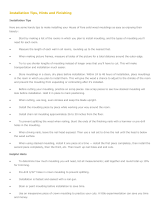
Page | 2
Use a high quality Acrylic latex or Oil based paint. Mouldings are factory
pre-primed and ready to paint or faux finish.
MEASURING AND CUTTING
Polyurethane Panel mouldings should be cut ¼” longer when filling a gap.
It would spring into place.
We recommend using a carbide saw blade with 80 (80T) or 120 (120T)
teeth or more.
If using a compound mitre box, follow the manufacturer’s instructions
when mitering angles for inside or outside corners.
INSTALLATION
Polyurethane Panel mouldings can be glued, nailed or both. It cuts just like
wood and it also copes just like wood.
Place level and mark a line where moulding will be installed.
Apply a continuous ¼” bead of premium polyurethane construction
adhesive such along the back edges of the panel moulding. When
applying glue to seams, wipe away any excess glue immediately before
it can harden. Then once glue is dried, repeat if necessary with
adhesive or filler.
Hold down Panel moulding into place. Make sure it is tight against
the wall. Follow the pencil mark.
Nail though moulding by using a finisher nailer or hammer. Finisher
nailer will speed up the process of installation.
Continue to install the next piece by making sure they ends butt
together clean. Make sure to glue all joints. It is strongly
recommended splicing panel mouldings with a Scarf Joint. Scarf joint
is achieved by mitering the joining ends at 45° bevel angle from front
to back. On piece will overlap the other.
If walls are irregular, fill any small gaps with Painter's caulk.
When applying the painters caulk to fill in small gaps or holes from
finishing nails, use a putty knife. To clean excess caulk, use a sponge
or clean cloth. After dried, if needed, use a 220 grit sandpaper to
make the surface smooth. This will allow you to touch-up or paint.
American Pro Décor assumes no liability for Improper Installation.


